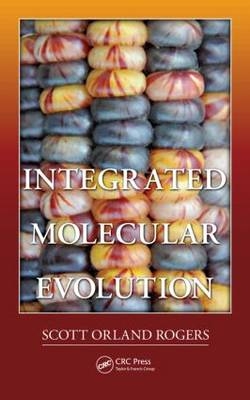
Integrated Molecular Evolution
Crc Press Inc (Verlag)
978-1-4398-1995-1 (ISBN)
- Titel erscheint in neuer Auflage
- Artikel merken
Incorporating the emerging fields of genomics and bioinformatics with traditional fields such as evolution, genetics, and molecular biology, this volume explores a myriad of topics, including
Life on Earth and the possible origins of life
The evolution of organisms on Earth and the history of the study of evolution
Basic structures of DNA, RNA, proteins, and other biological molecules, and the synthesis of each
Molecular biology and the evolution, structure, and function of ribosomes
DNA replication and the various ways in which chromosomes are separated
Ways in which DNA can be changed to produce mutations, infectious causes of mutation, and repair of DNA
Definitions, evolution, and the importance of multigene families
Phylogenetic analysis and how researchers use the raw sequence data to reconstruct portions of evolutionary processes
Details of the genomes of a variety of organisms, from RNA viruses to eukaryotes, presented in order of complexity
Each chapter ends with a summary of key points, forming an effective review and enabling students to isolate critical material. The series of topics and the masterful integration of these topics lead students to a full understanding of evolution and the component processes that have led to biological evolution on Earth.
Scott O. Rogers, PhD, is a professor of molecular biology at Bowling Green State University, Bowling Green, Ohio. He received his BS and MS degrees in Biology from the University of Oregon, Eugene, and PhD in Plant Molecular Biology from the University of Washington, Seattle. He was an assistant professor and associate professor at the State University of New York College of Environmental Science and Forestry, Syracuse, New York, from 1989 through 2001, before moving to BGSU. He has taught courses in biology, botany, cell physiology, molecular biology, molecular genetics, bioinformatics, and molecular evolution. Research in his lab includes studies of microbes in ice, life in extreme environments, group I introns, molecular microbial phylogenetics, microbial metagenomics, ancient DNA, and plant development.
Definitions of Life
RNA and Life
Detecting Life
Defining Life
Imagining Cellular and Molecular Dimensions
Earth and Evolution
What is Evolution?
Earth History
A Short History of the Study of Evolution
Earth History as One Year
DNA → RNA → Proteins
Nucleic Acids
Translation
Amino Acids and Polypeptides
Lipids
Carbohydrates
The Central Dogma and Beyond
Ribosomal RNA (rRNA)
Transfer RNA (tRNA)
Messenger RNA (mRNA)
Other Small Noncoding RNA (ncRNA)
Beyond the Central Dogma
Evolution of Ribosomes, Ribosomal RNA, and Translation
Ribosomes as Ribozymes
Translation
Origin of the Ribosome
Evolution of the Genetic Code
Why a Triplet Codon?
How Many rRNA Copies Are Needed?
Specific Mechanisms for Increasing rRNA Gene Copy Number
Complexity of Ribosomes
DNA Replication
Variations of Replication
Topology during Replication
Replication of Chromosomes
DNA Segregation
Variations on DNA Segregation in Bacteria (and Archaea)
Mitosis
Variations on Mitosis and the Cell Cycle
Variations on Chromosome Number
Changes in DNA Amount during the Cell Cycle
Meiosis
Changes to DNA
Causes of Mutations
Mutation during Replication
Effects of Mutations
DNA Repair
Genetic Recombination
Viruses, Plasmids, Transposons, and Introns
Viruses
Introns
Transposable Elements (Transposons and Retrotransposons)
Plasmids
Horizontal Gene Transfers
Species, Taxonomy, and Gene Flow
What Is a Species?
Classification of Life
Reconstruction Evolutionary History
Gene Flow
Multigene Families
Ribosomal RNA Gene Family
Globin Gene Family
Bacterial Flagella Gene Family
Laccase Gene Family
Histone Gene Family
Orthologs and Paralogs
Phylogenetics: Evolutionary Reconstructions
Tree Terminology
Choosing Genomic Region
Aligning Sequences
Other Considerations When Performing Phylogenetic Analyses
Analyzing the Aligned Sequence
UPGMA (Unweighted Pair Group Method with Arithmetic Mean)
Neighbor Joining
Maximum Parsimony
Maximum Likelihood (ML)
Bayesian Phylogenetic Analysis
Bootstrapping
Vertical versus Horizontal Evolutionary Events
Genomes I: RNA Viruses
C-Value Paradox
Genomics
HIV
Influenza A
Ebola
Genomes II: DNA Viruses
Bacteriophage ϕX174
Bacteriophage Lambda (λ)
Bacteriophage T4
Mimivirus
Genomes III: Bacteria and Archaea
Escherichia coli
Photosynthetic Bacteria
Aquifex
Euryarchaeota
Crenarchaeota
Genomes IV: Mutualists and Pathogens
Termite Gut Microbes
Smallest Bacterial Genome
Co-Resident Symbionts
Animal Parasite
Genome Mixing and Sorting
Genomes V: Endosymbionts and Organelles
Intracellular Endosymbiont
Mitochondria
Chloroplasts
Endosymbioses Leading to Other Organelles Evolution
Genomes VI: Eukaryotic Genomes
Origin of the Nucleus and Mitochondrion
Multicellularity
Chromalveolates
Ophisthokonta (including humans)
Plantae
Bibliography
| Erscheint lt. Verlag | 12.8.2011 |
|---|---|
| Zusatzinfo | There will be a 32-page color insert containing 32 figures.; insert to follow page 208 of book; 15 Tables, black and white; 197 Illustrations, black and white |
| Verlagsort | Bosa Roca |
| Sprache | englisch |
| Maße | 156 x 234 mm |
| Gewicht | 726 g |
| Themenwelt | Naturwissenschaften ► Biologie ► Evolution |
| Naturwissenschaften ► Biologie ► Genetik / Molekularbiologie | |
| ISBN-10 | 1-4398-1995-5 / 1439819955 |
| ISBN-13 | 978-1-4398-1995-1 / 9781439819951 |
| Zustand | Neuware |
| Haben Sie eine Frage zum Produkt? |
aus dem Bereich



